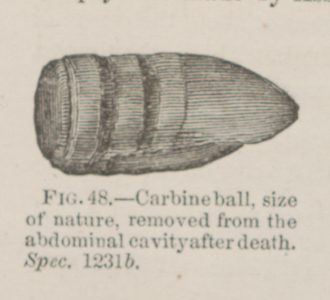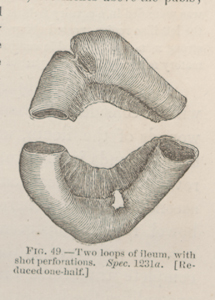Title: B——, Charles
Source text: The Medical and Surgical History of the War of the Rebellion. (1861-65.), Part 2, Volume 2 (Washington, DC: Government Printing Office, 1876), 71.
Civil War Washington ID: med.d2e31574
TEI/XML: med.d2e31574.xml
CASE 221.—Private Charles B——, Co. L, 8th New York Cavalry, aged 23 years, was wounded at Beverly Ford, June 9, 1863. He was conveyed to Washington on the next day, but died in the ambulance on the way to Lincoln Hospital. An autopsy was made by Assitant Surgeon H. Allen, U. S. A. The wound was in the median line, five inches above the pubis; the stomach was distended with gas; the intestines were natural in position, not abnormally distended, but greatly discolored by hæmorrhage. A moderately sized venous clot was found on the inferior surface of the omentum. The cellular tissue about the mesentery was emphysematous. The posterior part of the abdomen was filled with a large black clot, in the midst of which was an ascaris lumbricoides. The missile, a conical carbine ball (FIG. 48), was found in the pubis on the right side of the bladder, lying on the peritoneum. The lining of the œsophagus was unusually pale; the epiglottis presented a peculiar appearance, its mucous lining being of a purple color, with several dark grayish spots upon its laryngeal surface. The liver weighed thirty-four and one-fourth ounces, and was of an intense green color; the kidneys were extremely flabby and anæmic, and the cellular tissue surrounding them, emphysematous. The right kidney weighed five and one-half ounces, and measured five by two and one-half inches; the left weighed six and one-half ounces, and measured five by two and one-half inches. The spleen weighed four ounces, and measured four and one-half by three inches. Two sections of the small intestine, showing perforations by the missile, are figured in the wood-cut (FIG. 49). The specimens were contributed to the Museum by Surgeon G. S. Palmer, U. S. V.

